7v7 Flag Football Plays – 9 NFL Concepts
Most of you who play on an adult 7v7 flag football league are passing the ball a little more than a 5v5 youth flag football team normally does. You might be playing in a very talented adult flag football league. You may be competing in girls’ high school flag football or college women’s 7v7 flag football. This is why FirstDown PlayBook is setting you up with these nine passing game concepts that you will see in the NFL every week. If you practice them, they will fit perfectly with your 7v7 flag football pass game, too. See how the Ottawa Braves won back to back NAIA Women’s Flag Football National Championships using FirstDown PlayBook.
The natural question might be, “Can we really execute NFL concepts with our flag football offense? Of course you can. In fact, you have an advantage that NFL coaches do not. These concepts are so tried and true that NFL defenses expect them. The 7v7 flag football defenses you play against will not. Let’s find the flag football passing concepts that are right for your 7v7 flag offense.
And don’t forget, you can also use the FirstDown PlayBook™ Flag Football Library & Play Drawing Tool to find more passing concepts for your offense and edit them to your liking!
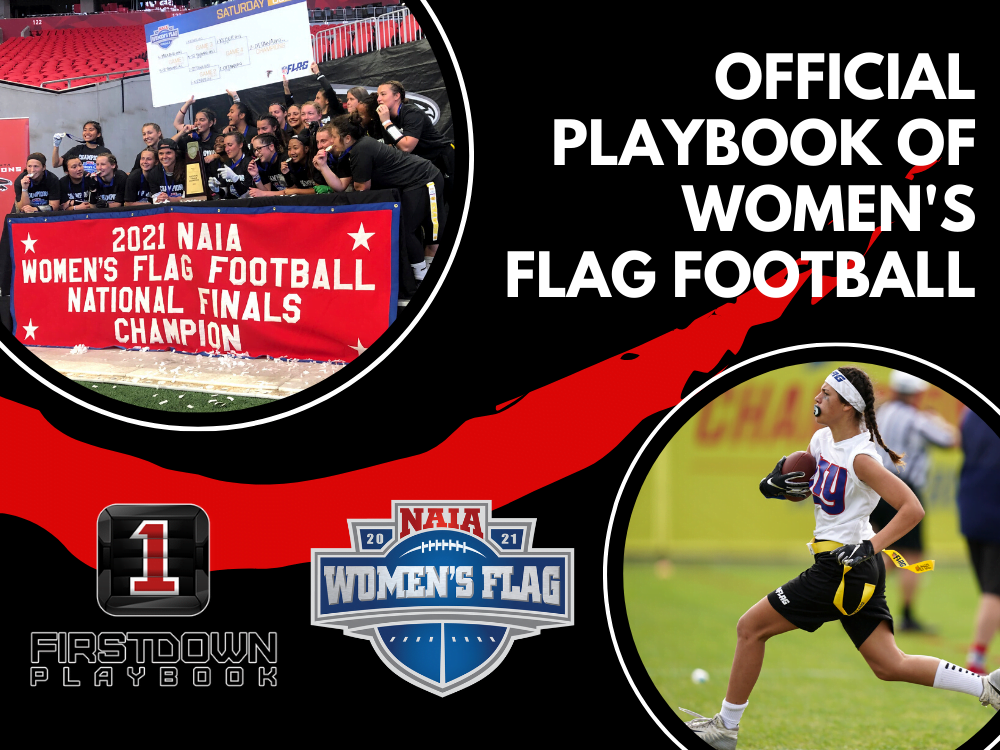
1. NFL Snag Concept
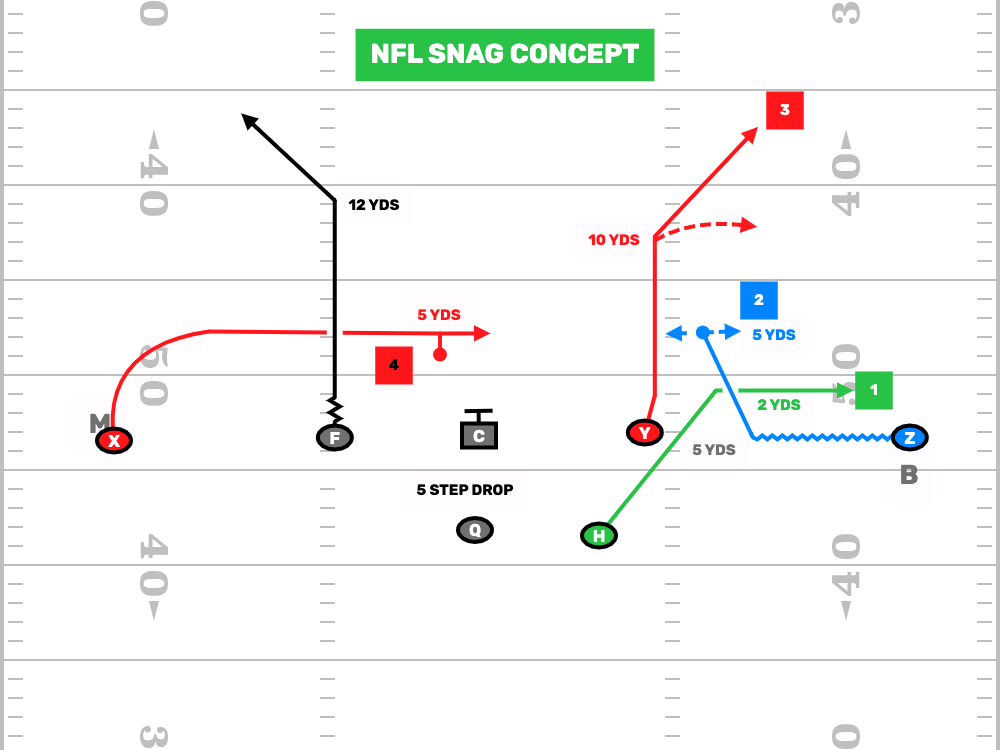
Adult 7v7 Flag Football Read: 1. Flat 2. Snag 3. Corner
One of the first things you learn about 7 on 7 flag football is that it is played fast. Very fast. You will not have much time to get the ball out of your quarterback’s hand. This 2×2 formation version of the Snag concept is made just for this situation.
You are going to want your three receivers in this concept to be near one another at the snap. You can see here we have motioned the Z receiver to almost a bunch set at the snap. The idea with the Snag concept is to create a three-level concept where the defense has to defend all three receivers quickly.
Here’s A Complete Tight End Route Tree
The Y wants to outside release on the snap. This may seem unimportant but you will soon see that we are making this look just like some other plays we are going to run. The Z will push up to 5 yards depth and sit down right in the stem or path where the Y just vacated. The H must expand the concept quickly and be ready to catch the ball as soon as they pass the Z. Once again, this concept happens very fast.
In this diagram, we are reading the flat route first, then the Z snag, and then the Y corner. If you want, you could choose to read this concept deep to shallow. The only thing we strongly advise is to stay on the snag side only, unless the quarterback breaks into a scramble. If your center will give the quarterback just a little time, this can lead to some great yardage after the catch.
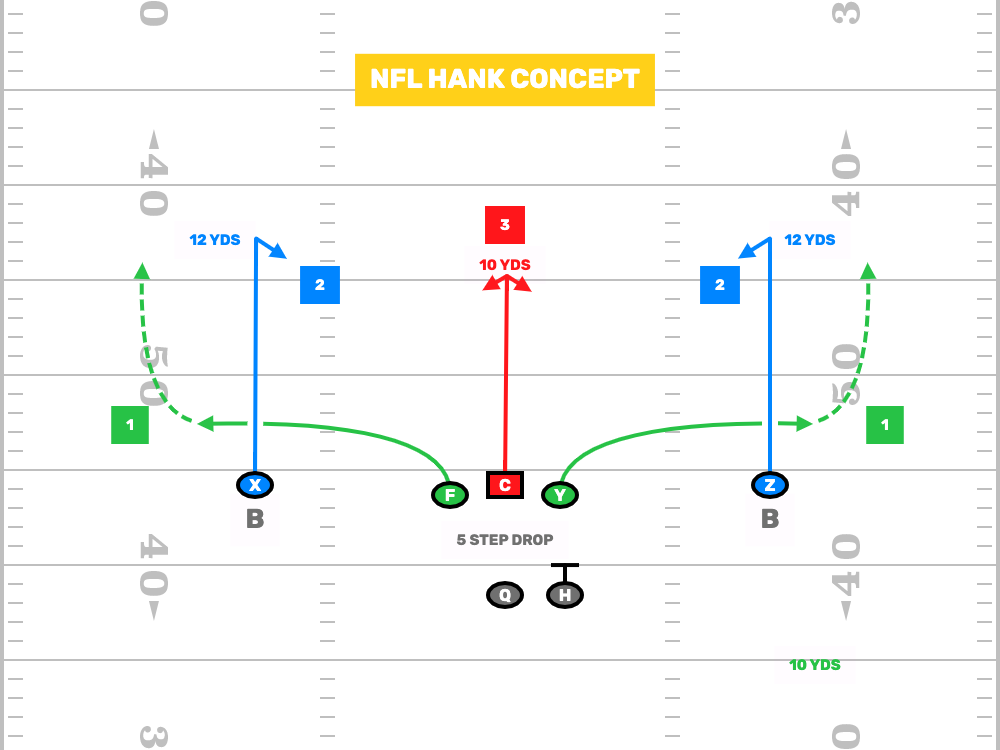
2. NFL Hank Concept
Adult 7v7 Flag Football Read: 1. Flat 2. Curl 3. Hook
You will see a lot of Bunch formations in 7 on 7 flag football. This is true in Women’s College Flag Football too. The reason is that you are also seeing a lot of man coverage. Two or three players in a bunch allows you to release on the snap and possibly get a pick or a rub on the defenders. A Bunch formation with the center involved can also be used to create pass protection for your quarterback with three players pass protecting.
We also like this Center Bunch formation for another reason. It is a great formation to run the Hank concept out of. The NFL Hank concept is just two curl routes from the outside receivers and flat routes by the slot receivers. When the flat routes from Bunch, it allows your quarterback more time to read the curl flat combination.
More About The Hank Concept
Your 7-Man flag football quarterback wants to simply choose a side to work pre-snap or as they drop. If the flat is there, take it right away. If the defense expands to cover the flat, work inside to the curl route. These curl routes should be coming directly back to your quarterback. Your center gives you a third option. They can slide either way to gain separation from their defender.
You may have noticed the dotted lines extending out from the flat routes. Yes, you have natural wheel routes off of your Hank concept after you run it a few times. This is why it’s a good idea to keep your back in to protect. This will give you time to throw it to the wheel routes if they are open. You can also keep your center in and just read the curl to the wheel from either side.
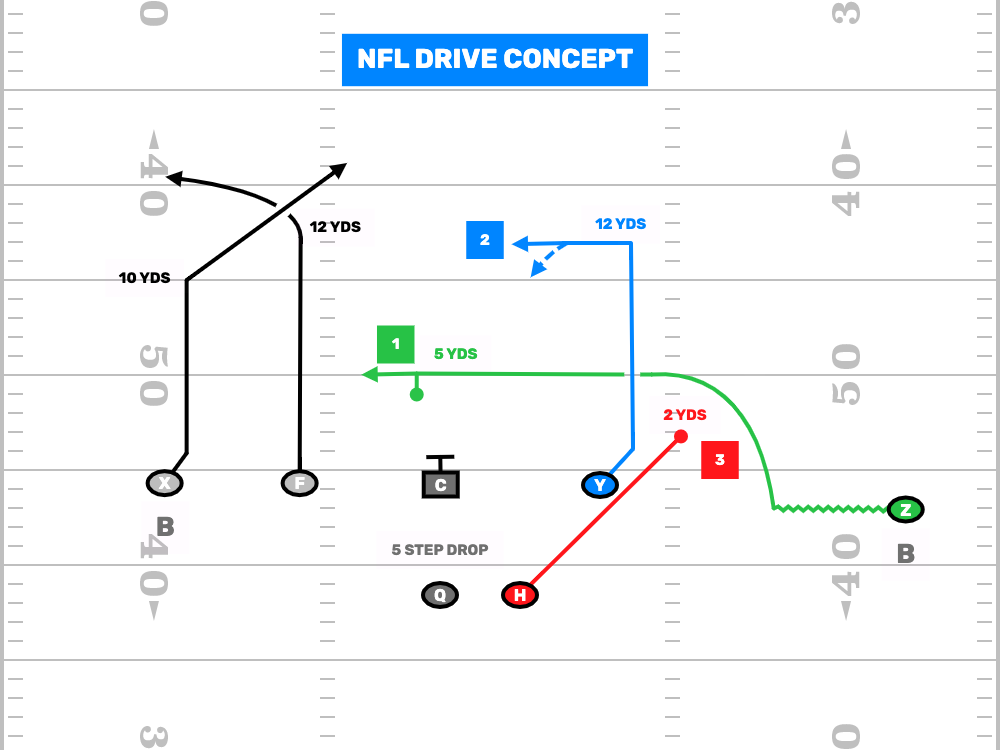
3. NFL Drive Concept
Adult 7v7 Flag Football Read: 1. Shallow 2. Basic Cross 3. Back
If there was a rule that allowed us to only run one NFL concept in adult 7 on 7 flag football, we would choose the Drive or Mesh concepts. When you play against man coverage as often you are going to in your 7 Man flag football league, you want your receivers on the move. The NFL Drive concept does this and they are right in your quarterback’s vision.
Go back and look at the Snag concept above. Starting to get the picture? These concepts are at their best when you run them in conjunction with one another. You are going to see the outside receiver (Z, in this case) motion inside to a Bunch type formation with the Y and the H. When you compare the two concepts, you can see how the defense has trouble defending both.
With the NFL Drive concept, you want your inside receiver to outside release so that they can set a natural pick for your shallow runner. The Z must run directly at the Y so that their defender will run into the Y or the defender covering them. The Y runs what is called a basic cross route.
The Basic Cross & Stick Routes Are A Tight End’s Best Friend
The basic cross is not just a pick player. They are very much in this route concept after getting the shallow runner open. The basic is going to push up to 12 yards and then cross over the middle as the QB’s second option.
You are not going to get very much zone coverage in flag football but you will see it sometimes. We saw it some in the NAIA Women’s Flag Football Championship in Atlanta. This is why you see that the basic and the shallow runners both have zone coverage adjustments to sit down if they need it.
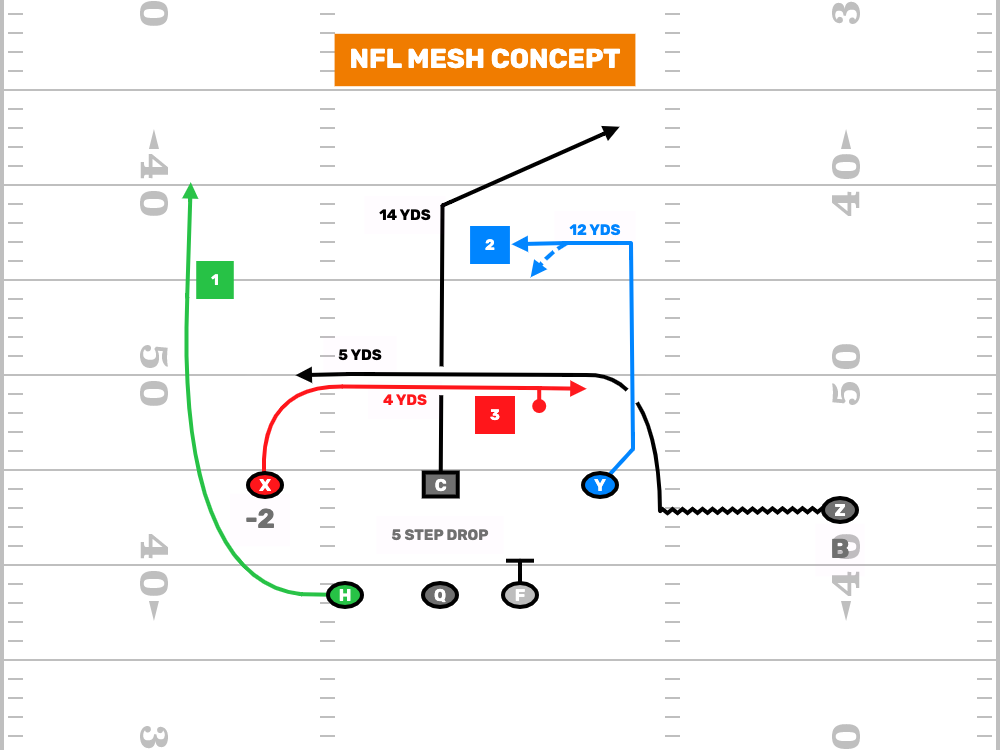
4. NFL Mesh (Shallow Cross) Concept
Adult 7v7 Flag Football Read: 1. Wheel 2. Basic Cross 3. Shallow
Mesh is an overused word in football. You hear it so much on TV and the internet. Do you (or they) even know what it is? Well, it’s not complicated. It is a combination of routes running across the field in close proximity to one another. These are good routes to run vs man coverage. Here is what is rarely coached. You must determine who is running interference for the shallow or drag route and who you are targeting. This is all tied into the direction they are running in relation to the basic cross route too.
More On How To Run Mesh Concepts
When you run the Drive concept, both the shallow cross route and the Basic route are running in the same direction. When you run the Shallow Cross concept, they are coming from different directions. It’s really that simple. Simple for you, that is. The defense has no idea who you are really trying to get open on both of these “man beater” concepts.
If this were a normal Mesh concept, we would have just run the back on a swing, and you can too. For the diagram here, we have added a wrinkle that you will like. Your back is running a wheel so you can look to them as your number one read, then still come back down to the basic cross to shallow read. This is why we have the F helping your quarterback out with protection.
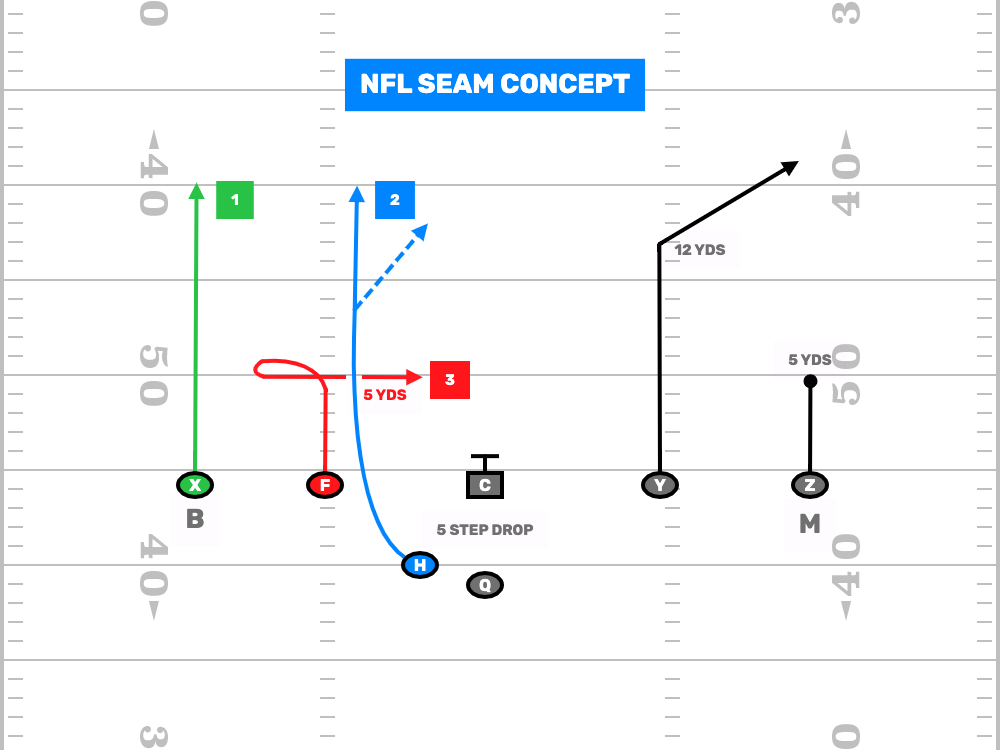
5. NFL Seam Concept
Adult 7v7 Flag Football Read: 1. Go 2. Seam 3. Under Or 1. Seam 2. Under
Okay, let’s stretch the field. We know your foot has been twitching waiting on that. Hold on though. We are not going to stretch it like you think. Look, if you have adult 7-Man flag football players who can line up and run vertically to get open every time, you do not need us. Line up, call four verticals every play, launch it, and go enjoy an adult beverage after the game.
Now back to the 99.9% of the rest of us. Stretching the field can be done in more ways than one. A great way to do it is to get a player down the seam who the defense does not expect. You might be thinking that this is going to take longer to develop. Yes, it does. That’s why you have to have an outlet to compensate for this seam concept.
More Ways To Throw The Seam…
You can see that we have cheated our back forward a little in this formation. You should too. On the snap, this back is going to release vertically and also get width to be friendly to the QB. You can read this seam concept a couple of different ways. If you have a speedy and talented X, then read it X to H, then back down to the F. The defense will be nervous about the X and probably lean that way. If so, then your QB should get back inside to the H.
Honestly, what we really love about this play, and others like it, is the under route. Check downs are boring, right? Not if they are coming underneath at 100 MPH and have the ball in their hands. We like this so much that we think you can leave the X out of the read and just go high to low with the H to F.
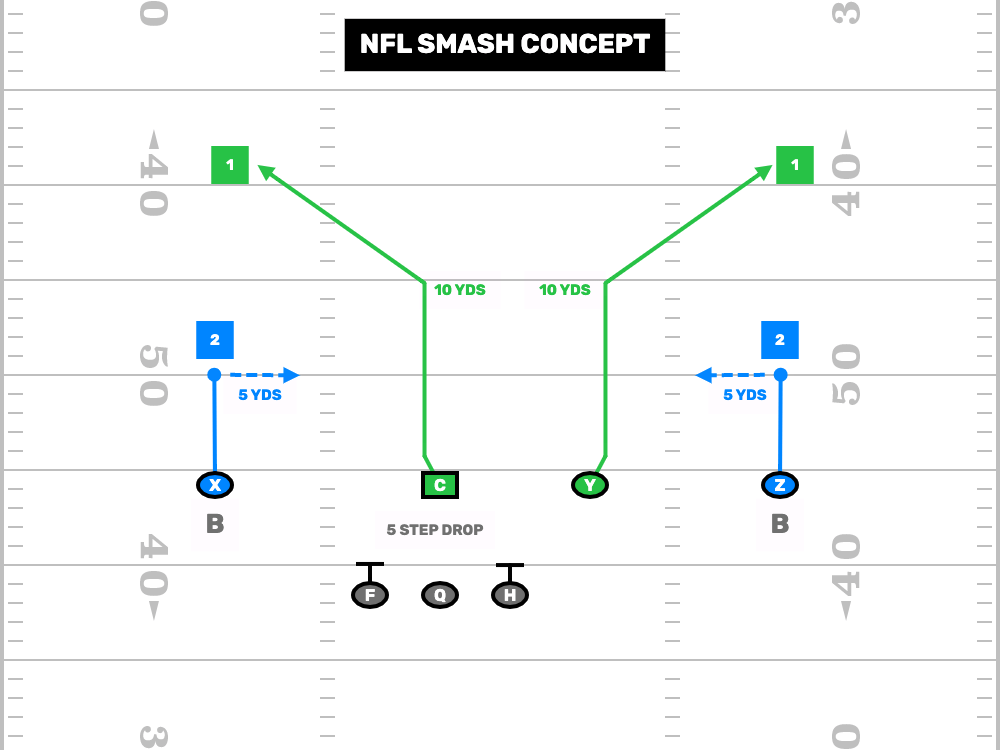
6. NFL Smash Concept
Adult 7v7 Flag Football Read: 1. Corner 2. Hitch
The NFL Smash concept is good regardless of what league you play in, but we have a special reason for liking it here. When you draw your 7 on 7 flag football plays, you will probably make a common mistake. You will forget about your center. Girls high school 7v7 flag football coaches are guilty of this too.
It’s easy to do because you have to be creative when it comes to including your snapper in the read. It’s important though. Oftentimes, a defense will cover your snapper with one of their slowest defenders. That can be a matchup that you want to expose.
More Ways To Throw The Smash Concept
Also, you will be using your center to protect, at least a little. This can put the defense to sleep when it comes to covering the snapper. Like other NFL concepts that we have shown you, this version of the Smash concept is being run to both sides. That is not mandatory. You could always choose to run the smash concept to one side and pair another concept on the other side. With this particular version, we are keeping two protectors in so that your quarterback can launch it if they have a deep winner on a corner route.
When you run the Smash concept vs zone coverage, you simply throw where the flat defender is not. If the flat defender bites the hitch route, then you throw the corner. If the flat defender sinks, then you throw the hitch. Once again, you will likely get man coverage vs your 7 on 7 flag football offense so we like to read this deep to the corner down to the hitch. You will notice the hitch routes burst inside late to separate from man coverage.
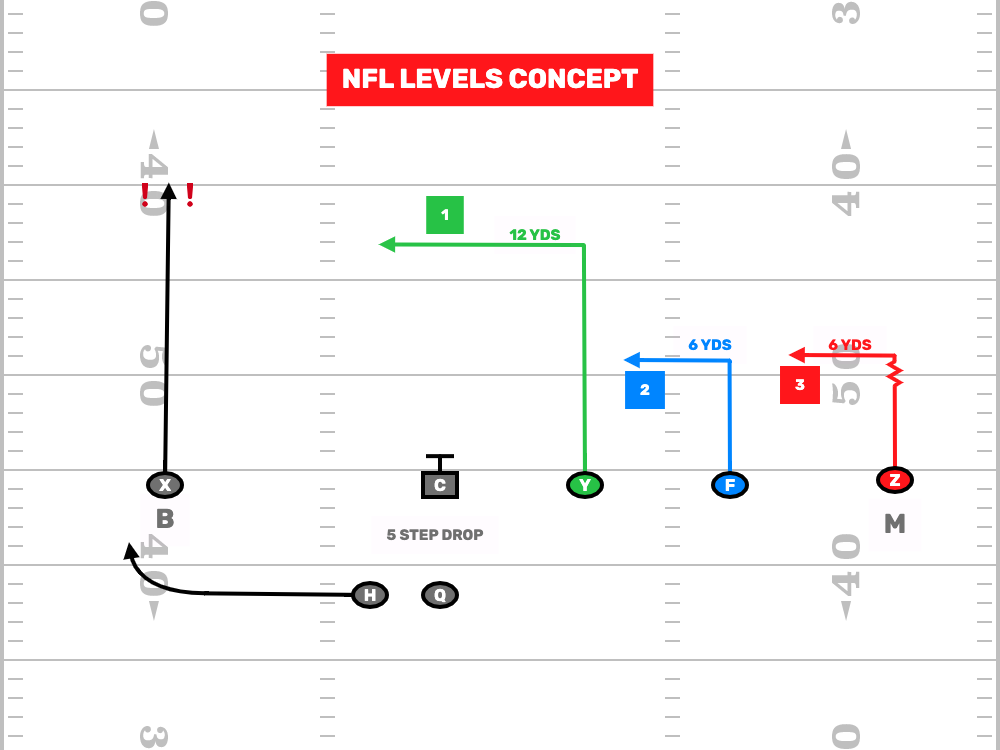
7. NFL Levels Concept
Adult 7v7 Flag Football Read: 1. In 2. China 3. China
When it comes to YAC (yards after catch), it is hard to beat the NFL Levels concept. Stretching the field is important. You want the defense on their heels every time you snap the ball, expecting someone to run by them. However, when you set this tone, it is now time to feed your athletic receivers underneath and let them eat.
This NFL Levels concept version is run from a 3×1 offensive formation. it can be run from a 2×2 or 2 Back formation too. All you need is two or more receivers coming across the middle of the field into your quarterback’s vision. The first coaching point is to make sure your receivers all sell the deep route as they release. Make the defense back up first!
A Complete Flag Football Route Tree Here
You will want to read this concept deep to shallow. It is very important that your deep in-route gets every inch of their 12 yards. You don’t want your in-route to be too close to your China routes. You need separation horizontally and vertically on this play so that your QB has a clean read. Notice how the Z has a max split so that they are not coming inside too close to the F. They can also stutter at the top of their route to ensure this as well. All of this ensures the proper spacing for your receivers.
Here is an additional coaching point: Your 7-Man flag football receivers want to get separation from their defenders but also come inside with a little tempo. What’s tempo? It means to come inside with enough coordination that you can make the catch. Quarterbacks…don’t knock them down with the ball either. Deliver a nice catchable ball that allows them to run for days.
Finally, this is a good concept to incorporate a go route on the opposite side. Like the one-on-one matchup? Throw the go route and come back to the Levels concept again later. If you don’t like the one-on-one matchup with the X, stay with your normal NFL Levels concept read.
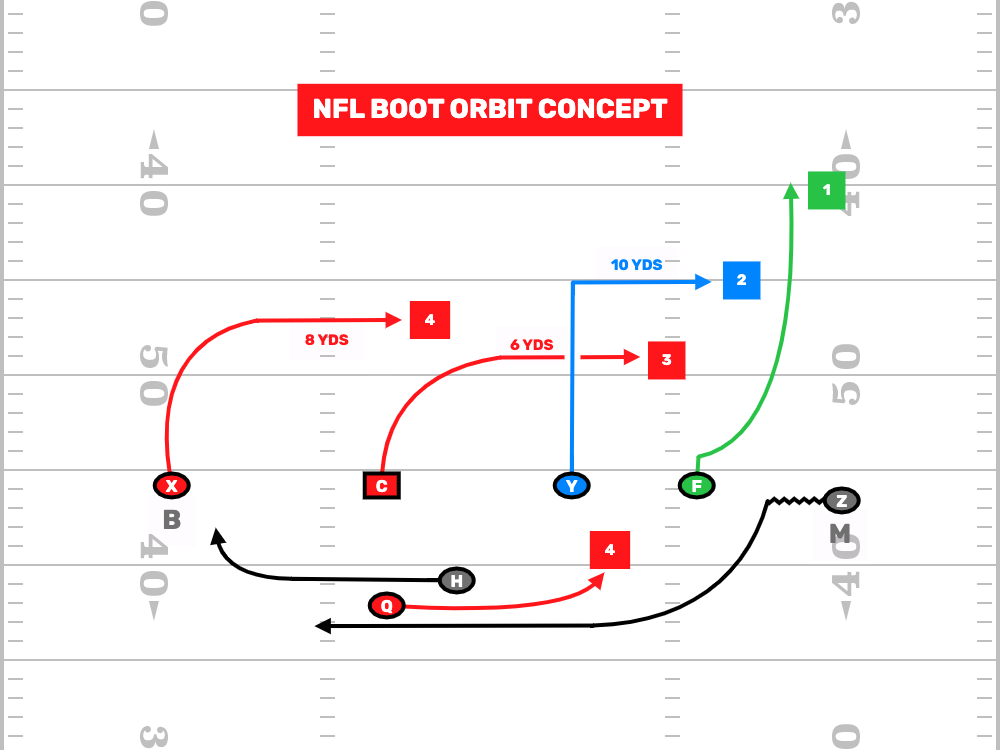
8. NFL Boot Orbit Concept
Adult 7v7 Flag Football Read: 1. Fade 2. Out 3. Quick Out
All quarterbacks are not created equally. If you coach girls high school flag football it is likely that you have one that has some athletic ability. You are going to want to move them around in the pocket some. There are several ways to do this, but the tried and proven NFL Boot Orbit is certainly a good way to start.
This is not your grand pappy’s bootleg pass. Think Sean McVay from the Los Angeles Rams. He does a great job of setting his boot game up off of his jet sweep and around game. You can too with your 7v7 flag football offense.
Obviously, you are going to want to have a play where you hand this ball off to your Z on the around. You may even want to have a simple play where you hand it off to a talented H. Either way, this bootleg pass will come off of those two run plays.
The Orbit concept has the widest receiver outside releasing on a fade or go route. The outside release is mandatory. This will force the defender to turn away from the inside routes as they cover the go route. The inside receivers will run an out route and a quick out route. Once again, it is important for both of these two receivers to be at their proper depth. If they are too close together, you are asking for an interception.
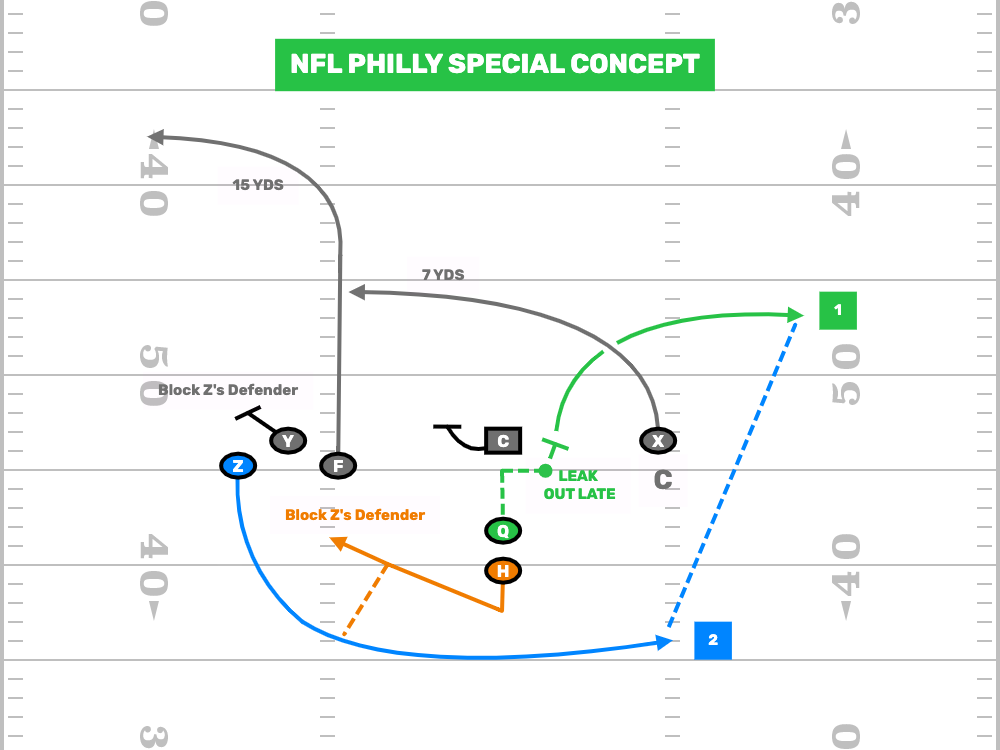
9. NFL Philly Special Concept
Adult 7v7 Flag Football Read: 1. QB Leak Late 2. Z Around Run
Every football team needs to have a few tricks up their sleeve. NFL teams and your 7 Man flag football team are no exception. We want to point out that there are plenty of around and jet sweep passes we could choose here. However, the NFL Philly Special brings a lot to the table when it comes to catching a defense flat-footed.
The first coaching point here is to know which hand your Z receiver throws with. For this 7 on 7 football diagram we are treating it like our Z is right-handed. Lining up in a Bunch formation to the left ensures that they can have an easier throw into the end zone.
More FirstDown PlayBook Trick Plays…
Your quarterback will shift from the pistol or gun to the hip of your center pre-snap. Your H will now become your quarterback. This should all happen with a sense of deliberate urgency but not a panicked hurry. As soon as the QB is set, the H will take the snap and attack the bunch side of the formation. The width of the Bunch should be determined according to your Z’s speed.
On the snap, the Z will come back inside on an orbit path behind the H. Now, the defense is likely in man coverage. This means that the defender covering the Z may try to run with the orbit path. This is why the Y is going to block this defender. The H will flip the ball to the Z. H and the center will also shield the Z from any defender chasing in the backfield.
F and X? You need to be great actors as you wave your arms demanding that the H throw the ball to you. You want all of the attention to be on that side. Meanwhile, the quarterback is initially going to block the backside for the H. Late, late, late…the QB will leak out into the flat for the soft pass from the Z. If something happens and the QB is covered then the Z can run it for plenty of yardage..

